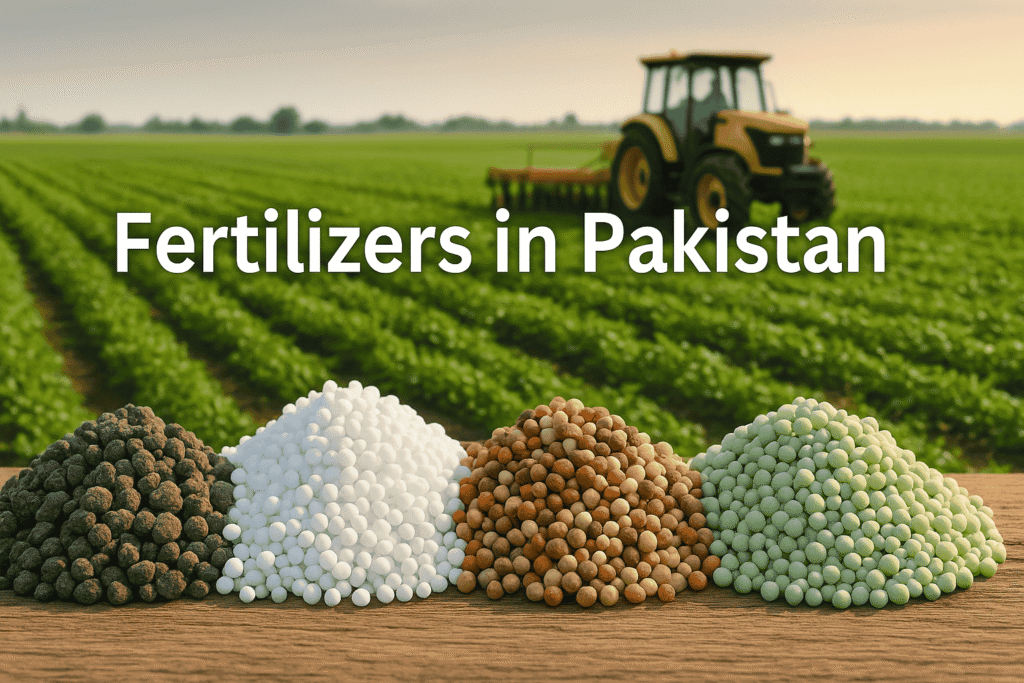Fertilizers in Pakistan: Boosting Crop Yield with Smart Nutrition Solutions
Fertilizer is the backbone of modern agriculture in Pakistan. With rising population demands, decreasing soil fertility, and climate variability, the role of fertilizer in boosting crop productivity and ensuring food security has become more critical than ever. From nitrogen-rich urea to micronutrient blends and bio-fertilizers, farmers today rely on diverse fertilizer products to feed their crops and sustain profitable yields.
Pakistan’s agriculture sector, which contributes nearly 19% to GDP and employs over 38% of the labor force, depends heavily on efficient fertilizer use. But not all fertilizers are equal — understanding their types, formulations, mode of action, and application techniques is essential for sustainable farming.
🌾 Types of Fertilizers in Pakistan
Fertilizers used in Pakistan fall into four main categories:
- Nitrogenous Fertilizers in Pakistan:
- Urea: The most commonly used nitrogen Fertilizer in Pakistan. It contains 46% nitrogen and is fast-acting.
- Calcium Ammonium Nitrate (CAN): Offers more balanced nitrogen availability and is suitable for alkaline soils.
- Phosphatic Fertilizers in Pakistan:
- Diammonium Phosphate (DAP): Contains 18% nitrogen and 46% phosphorus. Widely used in wheat and maize.
- Single Super Phosphate (SSP): Contains 16% phosphorus and added sulfur, suitable for legumes and oilseeds.
- Potassic Fertilizers in Pakistan:
- Muriate of Potash (MOP): Contains 60% potassium. Helps in tuber formation and resistance to stress.
- Sulfate of Potash (SOP): Contains 50% potassium and 18% sulfur; better for chloride-sensitive crops like fruits and vegetables.
- Micronutrient & Bio-Fertilizers in Pakistan:
- Zinc Sulfate, Boron, Iron Chelates are increasingly used in micronutrient-deficient soils.
- Bio-fertilizers like Azospirillum, Rhizobium, and phosphate-solubilizing bacteria are eco-friendly alternatives gaining popularity in organic farming.
🏭 Leading Fertilizer Companies in Pakistan
Several key companies drive fertilizer production and innovation in Pakistan. Below is an overview:
1. Fauji Fertilizer Company (FFC)
FFC is Pakistan’s largest urea producer. Their products include:
- Sona Urea (Granular and Prilled)
- Sona DAP
- Zarkhez (NPK blends)
Mode of Action: Fast nitrogen release for quick vegetative growth. DAP offers slow-release phosphorus for root establishment.
2. Engro Fertilizers Ltd.
A major producer with strong farmer outreach:
- Engro Urea
- Engro Zarkhez (customized NPKs)
- Zinc & Micronutrient products
Mode of Action: Balanced nutrient delivery using crop-specific blends. Special formulations target wheat, rice, cotton, and maize.
3. Fatima Fertilizer Company
A joint venture under Fatima Group:
- Nitrophos
- Calcium Ammonium Nitrate (CAN)
- NitroKisan Biofertilizer
Mode of Action: Offers slow and sustained nutrient release, especially in arid zones. CAN and Nitrophos reduce nitrogen losses.
4. Pak Arab Fertilizers (Fatima Group)
Their products include:
- PakCAN
- PakAS (Ammonium Sulfate)
- PakZinc
Mode of Action: Soil-enriching formulations that boost nutrient availability and minimize leaching in sandy soils.
5. Sitara Chemical Industries
Known for:
- Sitara Zinc
- Sitara NPK blends
- Sitara Organic Bio-Boost
Mode of Action: Enhances micronutrient uptake and organic matter in soil through bio-enzymatic action.
🌿 How Fertilizer Works: Mode of Action
Understanding the mode of action of fertilizer helps farmers make better decisions. Here’s how different fertilizers work:
- Nitrogenous Fertilizer : Promotes leaf and stem growth. Urea quickly hydrolyzes into ammonium, absorbed by roots.
- Phosphatic Fertilizer: Crucial for root development and early plant establishment. DAP breaks down to release phosphorus steadily.
- Potassium Fertilizer: Enhances photosynthesis, water regulation, and disease resistance. MOP and SOP are absorbed directly.
- Micronutrient Fertilizer: Zinc, iron, boron, and molybdenum enable enzyme functions and nutrient transport.
- Bio-Fertilizer: Introduces beneficial microbes that fix atmospheric nitrogen, solubilize phosphorus, and enhance nutrient absorption.
Following the fertilizer use efficiency guidelines by FAO can help optimize input costs and minimize environmental impact.
📈 Fertilizers in Pakistan: Use, Trends & Challenges
Although fertilizer use has risen, imbalanced application remains a major issue. Farmers often overuse nitrogen (especially urea) while ignoring phosphorus and potassium. This leads to:
- Soil nutrient depletion
- Reduced crop quality
- Environmental pollution
Government of Pakistan and institutions like PARC and NFDC recommend a 4R approach: Right Source, Right Rate, Right Time, and Right Placement. Precision farming and soil testing can also improve fertilizer use efficiency.
🔗 Learn more about soil fertility strategies from PARC
🌍 Future of Fertilizers in Pakistan
The fertilizer sector is evolving with sustainable practices:
- Nano-fertilizers for higher efficiency
- Coated fertilizers to prevent leaching
- Organic and compost-based blends for eco-farming
Public-private partnerships, farmer education programs, and smart subsidies can help improve adoption of balanced fertilization. The future lies in site-specific fertilizer recommendations based on soil maps and AI-driven decision-making.
✅ Conclusion: Fertilizer for a Food-Secure Pakistan
A well-fed crop is a well-fed nation. Fertilizer plays a pivotal role in ensuring food security, increasing farm incomes, and restoring soil health. Pakistani farmers must shift from quantity to quality — choosing the right fertilizer, using it efficiently, and understanding its impact on soil biology and crop growth.
With ongoing innovations and support from companies like FFC, Engro, Fatima, and Sitara, Pakistan has the tools to transform agriculture. Sustainable fertilizer practices, combined with farmer training and digital advisory, can unlock the true potential of Pakistan’s fertile lands.
Because where fertilizer flows wisely, prosperity grows steadily.
